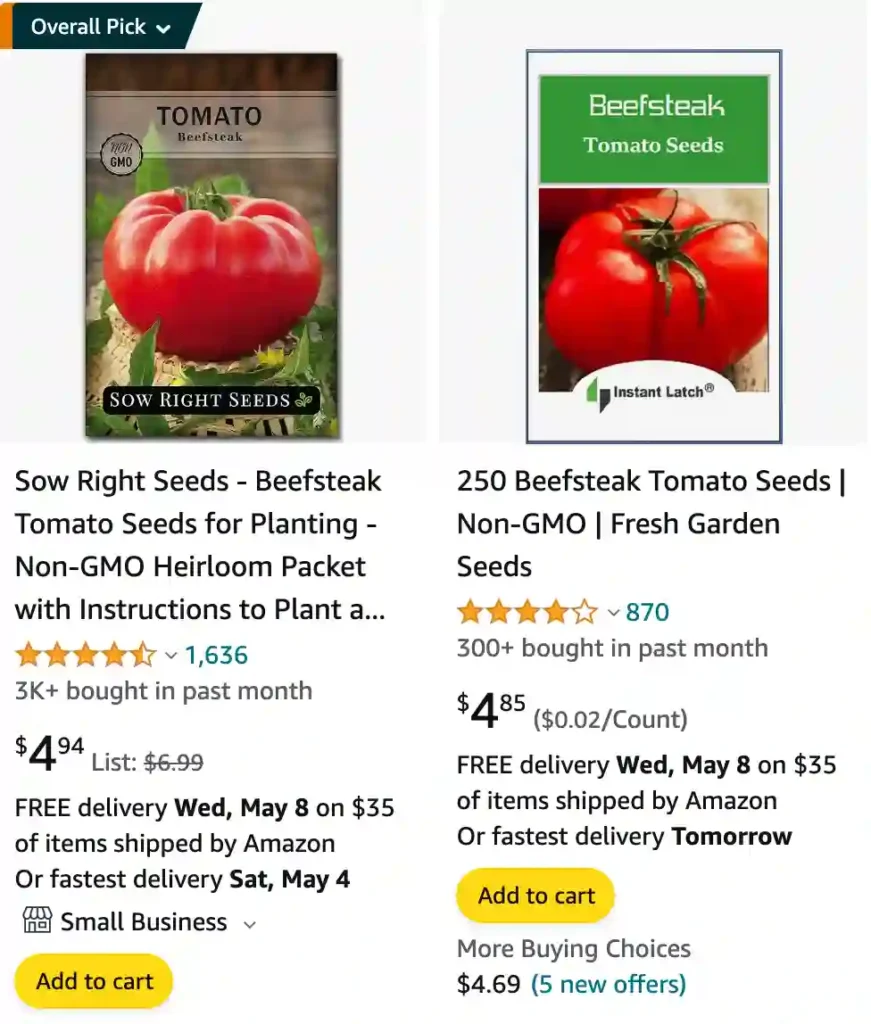
What is a beefsteak tomato?
A beefsteak tomato is like the king of all tomatoes in my garden. These aren’t your bite-sized cherry tomatoes – these are whoppers! They can get as big as my fist, sometimes even bigger, and they’re heavy for their size. The first time I picked one, I was surprised by how much it weighed in my hand. It felt like I was holding a whole lot of summer sunshine.
Are beefsteak tomatoes determinate or indeterminate?
I’ve found that beefsteak tomatoes are typically indeterminate, meaning they continue to grow and produce fruit throughout the season, which keeps my garden lively and productive.
How to grow beefsteak tomatoes?
Growing beefsteak tomatoes requires plenty of sunlight, consistent watering, and support for their large, heavy fruits. I’ve learned that pruning helps focus their energy on fruit production, leading to bigger and better tomatoes.
What are beefsteak tomatoes good for?
Beefsteak tomatoes are perfect for slicing thickly and enjoying fresh in sandwiches or salads. Their meaty texture and rich flavor really stand out, especially when paired with fresh basil and mozzarella in a Caprese salad.
What to do with beefsteak tomatoes?
When I have an abundance of beefsteak tomatoes, I love making homemade salsa or tomato sauce. Their juicy flesh cooks down beautifully into a rich, flavorful base for pasta sauces or as a dip for chips.
When to pick beefsteak tomatoes?
Picking beefsteak tomatoes is best done when they’re fully ripe on the vine, usually when they’ve turned deep red and are slightly soft to the touch. This ensures they’re at their peak flavor and sweetness.
How many beefsteak tomatoes per plant?
Each beefsteak tomato plant can yield quite a lot of fruit, typically around 10-15 tomatoes per plant in a good growing season.
How tall do beefsteak tomatoes grow?
Beefsteak tomato plants can grow quite tall, often reaching heights of 5 to 8 feet or even more if they’re well cared for and supported.
Are beefsteak tomatoes heirloom?
Yes, beefsteak tomatoes can be heirloom varieties, prized for their rich history, unique flavors, and often unusual colors or shapes.
How big do beefsteak tomatoes get?
Beefsteak tomatoes can grow quite large, often reaching sizes of 1-2 pounds per tomato or even larger under optimal growing conditions.
How many calories in a beefsteak tomato?
A medium-sized beefsteak tomato contains about 35-40 calories, making them a nutritious addition to meals.
How to grow beefsteak tomatoes in pots?
I’ve grown beefsteak tomatoes successfully in pots on my balcony, using large containers filled with nutrient-rich soil and ensuring they receive plenty of sunlight and water.
Why are my beefsteak tomatoes so small?
If my beefsteak tomatoes are small, it’s usually due to inconsistent watering or nutrient deficiencies in the soil. I’ve learned to monitor their care closely to ensure they reach their full potential.
How far apart to plant beefsteak tomatoes?
Planting beefsteak tomatoes about 18-24 inches apart gives them enough space to grow and allows for good air circulation, reducing the risk of diseases.
How long do beefsteak tomatoes take to grow?
Beefsteak tomatoes typically take 70-85 days to grow from seed to harvest, depending on the variety and growing conditions.
What to make with beefsteak tomatoes?
I enjoy making fresh bruschetta with diced beefsteak tomatoes, garlic, basil, and a drizzle of balsamic vinegar on toasted bread.
Are beefsteak tomatoes good for sauce?
While beefsteak tomatoes are great for fresh eating and cooking, they’re not typically preferred for making sauce due to their high water content compared to paste tomatoes like Roma.
Can you use beefsteak tomatoes for salsa?
While beefsteak tomatoes can be used in salsa, their juicy texture may require draining excess liquid to achieve the desired consistency.
Rutger Tomato vs Beefsteak
Rutgers tomatoes and Beefsteak tomatoes are distinct varieties, with Rutger tomatoes typically known for their excellent disease resistance and adaptable growth, while Beefsteak tomatoes are celebrated for their large size and rich flavor.
Beefmaster Tomato vs Beefsteak
Beefmaster is a hybrid, indeterminate Beefsteak tomato, although they share a similarity in the “beefy” description, are separate types, with Beefmaster tomatoes being a hybrid variety known for their sizable fruit and disease resistance, while Beefsteak tomatoes encompass a broader category characterized by their large, meaty texture and robust flavor.
Oxheart Tomatoes vs Beefsteak
The Oxheart Tomato stands out with its distinctive shape resembling an ox heart, distinguished by its large size akin to Beefsteak tomatoes, yet featuring a pointed, heart-like base, contributing to its unique elongated and pear-shaped appearance.
Big Beef vs Beefsteak Tomato
Big Beef Tomatoes represent an enhanced version of the Beefsteak hybrid, encompassing all the desirable qualities of Beefsteak tomatoes; notable for their sturdy vines, substantial size, abundant yield, and classic flavor, this robust variety distinguishes itself through its early maturation.
Tomatoes on the Vine vs Beefsteak
Tomatoes on the vine and Beefsteak tomatoes are distinct types, with tomatoes on the vine typically harvested while still connected to their vine for enhanced freshness, while Beefsteak tomatoes are characterized by their substantial size and meaty texture.
Floradade Tomato vs Beefsteak
Floradade tomatoes and Beefsteak tomatoes are different varieties, with Floradade known for its disease resistance and suitability for warm climates, while Beefsteak tomatoes are renowned for their large size and rich, savory taste.
Brandywine Tomato vs Beefsteak
Brandywine tomatoes and Beefsteak tomatoes are separate cultivars, with Brandywine known for its heirloom status, distinct flavor, and often larger size, while Beefsteak tomatoes are renowned for their substantial size, meaty texture, and rich taste.
Beefsteak Tomato vs Regular Tomato
Compared to regular tomatoes, beefsteak tomatoes are larger in size with a meatier texture and often have a sweeter, juicier flavor profile.
Beefsteak Tomato vs Roma
Beefsteak tomatoes differ from Roma tomatoes in their larger size, juicier flesh, and more irregular shape, whereas Roma tomatoes are known for their denser, less watery texture, and are often used for sauces and canning.
Beefsteak Tomato vs Tomato on the Vine
Beefsteak tomatoes are often sold on the vine for freshness, whereas regular tomatoes encompass a broader category that includes many different varieties, including beefsteaks.




